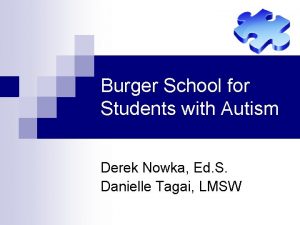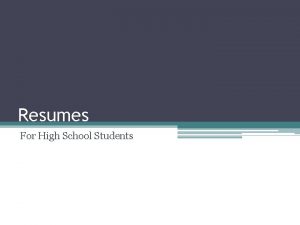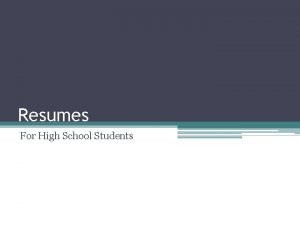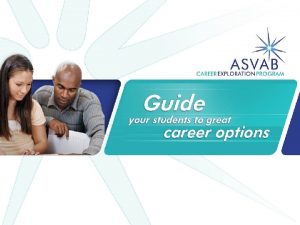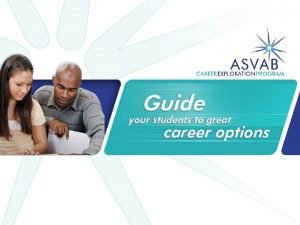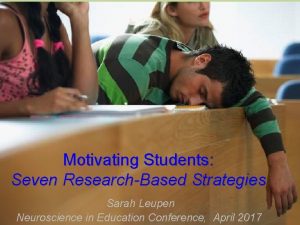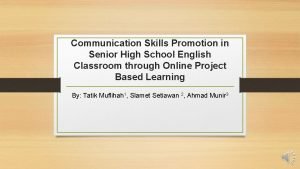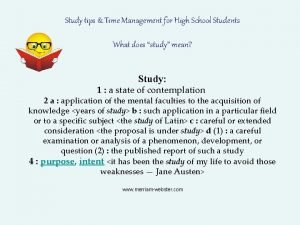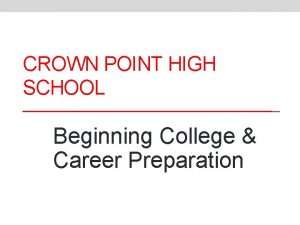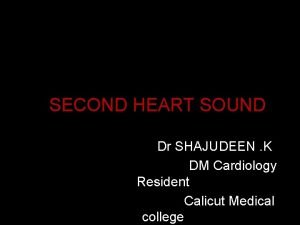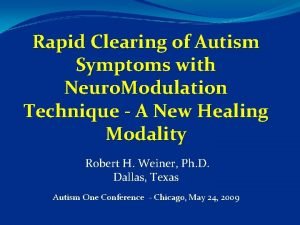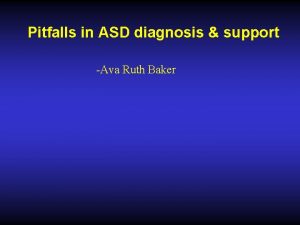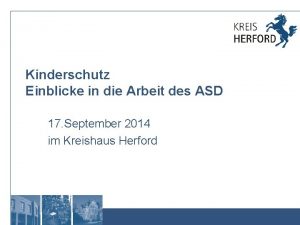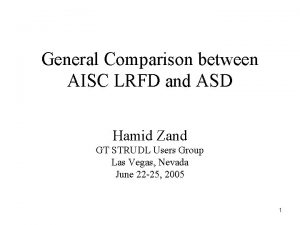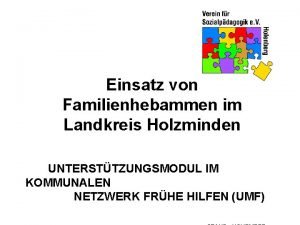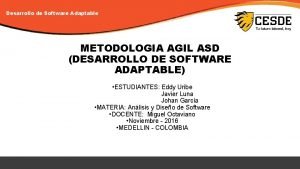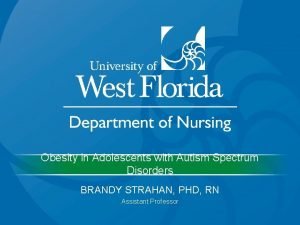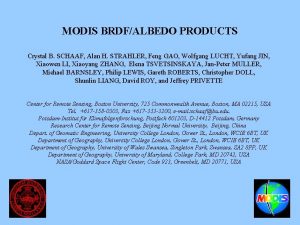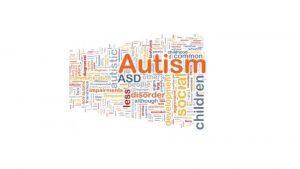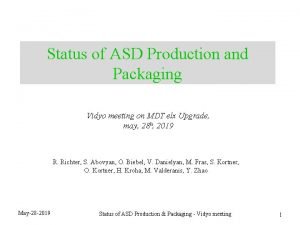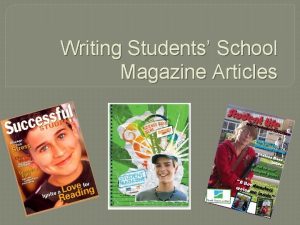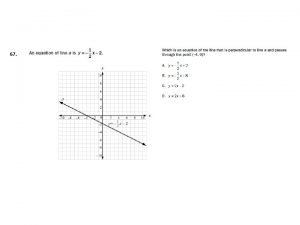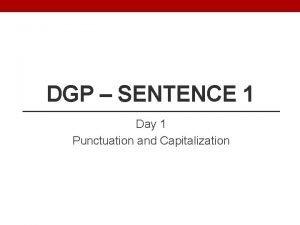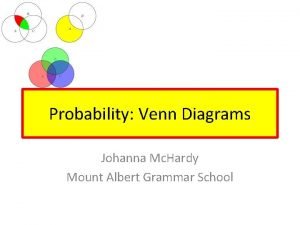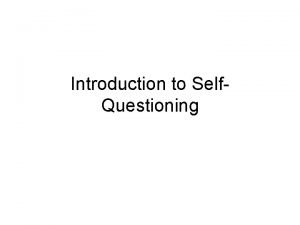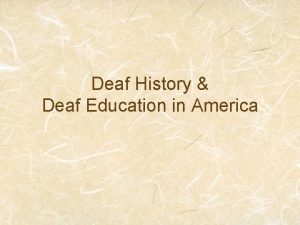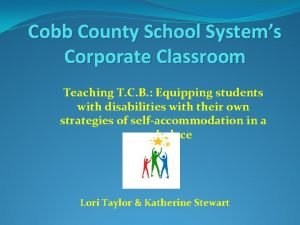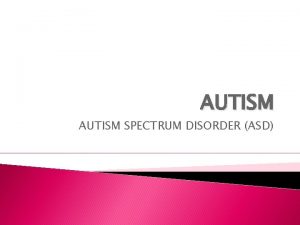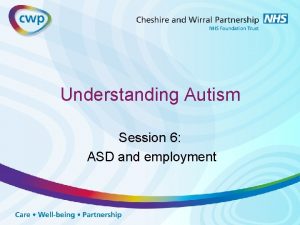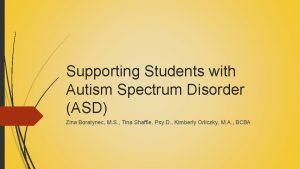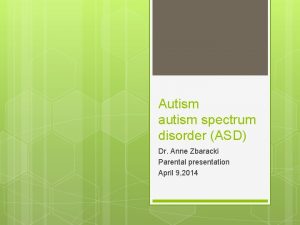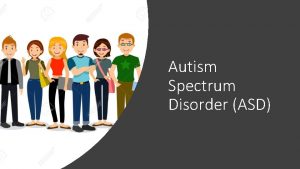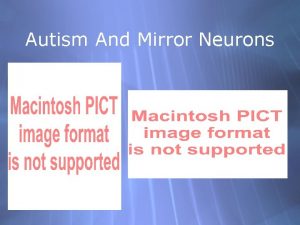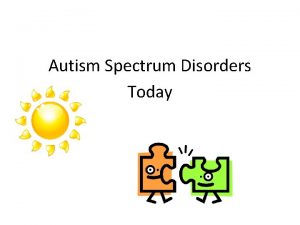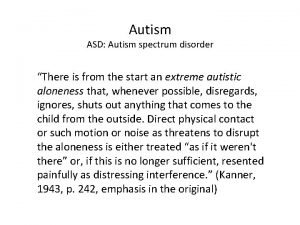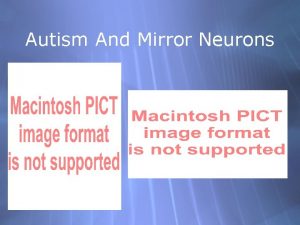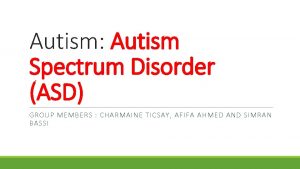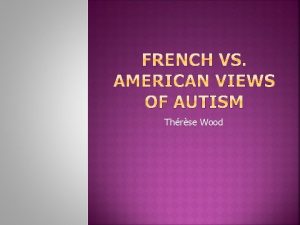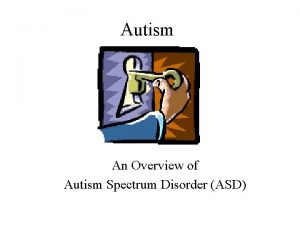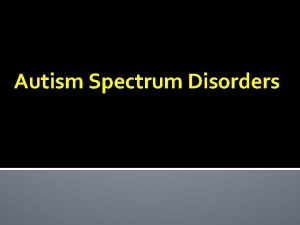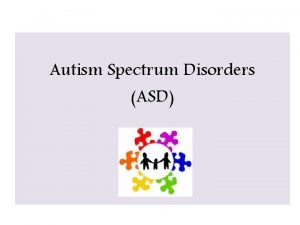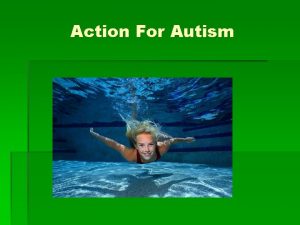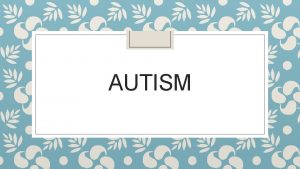Supporting Students with ASD High School Autism Point



























































- Slides: 59

Supporting Students with ASD High School Autism Point Person Training #2 10/22/12 Sabrina Beaudry & Pam Leonard

Today we will… O Review points from last training and hear your thoughts. O Share homework assignments. O Apply our knowledge of characteristics by practicing observing & describing. O Introduce a process for deciding how to support a student. O Introduce a system for planning and teaching supports. O Apply to a student you know.

In Review… We discussed different ways to describe autism: 1. Based on DSM criteria/descriptions 2. Based on personal accounts 3. Based on Psychological/ Brain Based Theories

In Review We: O Described students based on their individual characteristics of autism. O Began to understand how students with ASD THINK DIFFERENTLY due to neurological differences. O Had an assignment to apply the knowledge of characteristics in hopes of changing how another staff member might think about someone on the spectrum.

Let’s Share Assignment Experience: O Did you find yourself describing a student a little differently than you would have in the past? O How was your experience comparing descriptions of a student with another staff member? O Do you feel you made an impact in how someone else thinks of student challenges?

Let’s begin to talk about Supports Where do we start?

We start with a process O Knowledge base of disability including strengths O Assess= observing/describing O Determine Needs O Decide how to support needs O Put supports in across the day

TEACCH- The Philosophy Behind our Process 1. Use your understanding of the characteristics of autism as a means of understanding the autistic student's behavior and learning style, 2. Build new skills by developing each student's strengths and interests, 3. And using visual information to help students understand their schedule, academic content, or behavioral expectations. Recommendations For Students with High Functioning Autism by Kerry Hogan

Before we check off the first step of the process, let’s be sure to talk STRENGTHS O Processing visual information O Attention to details or selected areas of O O O O interest Sensory perception (touch, smell, sight, taste) Simple memory Rule learning Formal language Visuospatial processing Visual perceptual skills Routine learning

We’ve used our knowledge base to help us describe, now let’s use it to Communication Social Cognitive Emotional Sensory observe Regulation

Observe and Describe O Max comes home O Max with cousin O Max wants a dog

What Characteristics did you see? Communication Social Cognitive Emotional Regulation Sensory

Take your characteristics and define the needs (challenges) Communication Social Cognitive Emotional Regulation Sensory

We have now completed the first three steps O Knowledge base of disability including strengths O Assess= observing/describing O Determine Needs O Decide how to support needs O Put supports in across the day

Take a Break

What Next? Now let’s figure out how to support the students with the information about characteristics, strengths and needs in mind!

We all use supports Let’s begin by talking about how we (NT’S) think about our activities of the day, and the skills we have that let us deal with our daily activities. No one taught us to use these skills, we just innately use them!

An Overview of Today O Supporting ASD=Positive Behavior Supports

First…Where am I going? : As NT’s we: 1. Figure out where we are going O Old fashion paper/pencil planners O A calendars O I phones O Computer- outlook calendars

Next, when I get there, I like to know: O What I will have to do and how do I start O The amount I will have to do, or how long I will have to do something O When I will be done O What I will do next As NT’s, we intuitively figure this out

In Other Words… SADN Start Amount Done Next

Knowing SADN Allows All of Us: O To feel calm O To focus on what we should be focusing on O To act appropriately O To remain “regulated”

How do NT’s Know What “SADN” is? : For NT’s: 1. SADN information might be given to us O Course syllabus O Meeting agenda O Conference schedule O Workout plan 2. We use knowledge from past experiences

What SADN is cont… 3. We work to find out SADN on our own O Ask someone for the information O Look up/research the information we need 4. We use coping strategies O Zone out O Decide our own SADN O Become disengaged- think about other things

Now, let’s take a look at some other skills we (NT’s) innately use to deal with our day…

How will I communicate (expressive/receptive language) when I get there? As NT’s we: O Have reciprocal exchanges with others using age-appropriate language skills/vocabulary. O Have an understanding of advanced language and ability to use it.

How will I know how to act when I get there? As NT’s we: O Understand the hidden social rules of our society O Pull from past experiences with a variety of contexts/situations/interactions, etc. O Intuitively use skills from the cognitive processes related to theory of mind, executive functioning, & central coherence

What will I do if something goes wrong when I am there? As NT’s we: O Use problem solving skills O Use coping strategies O Use calming strategies

What if my body does not feel right, or I can’t focus? As NT’s we: O Use natural regulation strategies to maintain focus, etc. O Shake leg O Twirl hair O Excuse self for quick “break” O Doodle O Drink a lot of coffee, chew gum, etc.

So, the question is: How do we support students with ASD to do all of these things when it is not intuitive to them? ? !!

Let’s Take A Look at our Chart Again O Supporting ASD=Positive Behavior Supports

How do we help students with ASD know where to go? O Individual Schedules O Individual Planners O Individual Calendars We have to teach them to use independently

Examples: O DJ's schedule

How do we help students with ASD know what to do in a given place or context? (“SADN”) O Task Organizers O Countdowns O Timers We have to teach them to use independently

Examples: O General Classroom Task Organizer O Detailed Classroom Task Organizer O Grading your work O Outing organizer

LUNCH

How do we help students with ASD communicate? O Provide augmentative expressive language supports. O Low tech O High tech- voice output O Provide augmentative receptive language supports. O Visual supports for understanding of language We have to teach them to use independently

Examples I’ll be back

How will we support students with ASD in knowing how to act? O Social Communication & Social Thinking Supports O “Reminder” notebooks with social phrases and social rules for challenging contexts O Use of technology with an area for “reminders” O O Itouch iphone O Social Scripts O Social Stories O Social Behavior Maps O Video Modeling O Structured teaching built into day O O MGW concepts/curriculum Hidden Social Curriculum We have to teach them to use independently

Examples: O Social Behavior Map- Class Group O Social Behavior Map- Brown Cow O Circles Program- definitions O Social Behavior for Interviewing- ILAUGH model O Teaching to use support "Reminders"

How will we support a student with ASD in knowing what to do when things go wrong? O Provide calming routines O Provide relaxation techniques O Provide coping strategies O Provide strategies to improve awareness of emotions/behavior O Provide a problem solving process We have to teach them to use independently

Examples: O 3 Point Scale for Impulsivity O Zones of Regulation Example- General O Zones of Regualtion for Riding Public Transportation O Bookmark with calming routine O SOCCSS template


How will we support students with ASD in knowing how to regulate their bodies or focus? O Sensory “diets” O Regulation scales

Examples

SO in Summary! For our students with ASD…. We want to: O Provide a way for them to know where to go/when to go O Provide SADN supports for when they get there O Provide a communication support system O Provide a social emotional support system O Provide a sensory support system

Summary One Last Look O Supporting ASD=Positive Behavior Supports

When Supports Are In Place SADN Supports Communicatio n and Language Supports Social Thinking and Social Communicatio n Supports Social Emotional Supports Sensory Regulation Supports It allows for expected behavior Which allows for instructional control

We have now completed the fourth step of the process! O Knowledge base of disability including strengths O Assess= observing/describing O Determine Needs O Decide how to support needs

Your assignment is to complete the fifth step for a student Today…Pick a student and describe what supports are in place: O Schedule O SADN O Communication O Social Thinking and Social Communication O Emotional Regulation O Sensory Regulation

How do you teach these supports?

How does the student use these supports across their day?

What knowledge base do their teachers have of their support systems? Can they help them access them?

For Next Time: O Observe how independently a student uses his/her supports. O Would you decide to do more teaching to the support?

Resources Social Communication/ Social Thinking: O Michelle Garcia Winner resources: O www. socialthinking. com- Newsletter O Inside Out O Social Thinking O Thinking About You, Thinking About Me O Social Behavior Mapping O Social Thinking Worksheets O Socially Curious and Curiously Social O Sticker Strategies O Hidden Curriculum- Brenda Smith Myles, etc. O Social Stories- Carol Gray

Resources Social Communication/ Social Thinking: O Comic Strip Conversations O Building Social Relationships- Scott Belini O Jed Baker resources

Resources Social Emotional Regulation O 5 Point Scale O Zones of Regulation O SOCCSS strategy

Website Resources O O O www. iidc. indiana. edu/irca www. maapservices. org www. tonyattwood. com www. autism-society. org www. teach. com www. thegraycenter. org www. autismsociety-nc. org www. socialthinking. com www. udel. edu/bkirby/asperger (O. A. S. I. S. ) http: //www. asw 4 autism. org www. Do 2 Learn. com

See you next time!
 Burger school for students with autism
Burger school for students with autism Ivc summer classes for high school students
Ivc summer classes for high school students High school resume components
High school resume components Resumes for high school students
Resumes for high school students Asvab summary results
Asvab summary results Asvab program fyi
Asvab program fyi Teaching web design to high school students
Teaching web design to high school students Engagement strategies for high school students
Engagement strategies for high school students Socartive
Socartive Communication skills of senior high school students
Communication skills of senior high school students Career orientation for high school students
Career orientation for high school students Time management tips for high school students
Time management tips for high school students High functioning autism symptoms
High functioning autism symptoms High functioning autism
High functioning autism Rizal involved in student demonstration
Rizal involved in student demonstration Cphs rds
Cphs rds Supporting points example
Supporting points example Asd
Asd Splitting of second heart sound
Splitting of second heart sound Wide fixed split s2 in asd
Wide fixed split s2 in asd Pddbi score interpretation
Pddbi score interpretation Ava asd
Ava asd Familienberatung herford
Familienberatung herford Lrfd
Lrfd Asd holzminden
Asd holzminden Metodologia rup definicion
Metodologia rup definicion Cyanotic vs acyanotic
Cyanotic vs acyanotic Wake tech admissions
Wake tech admissions Asd 3000l
Asd 3000l Asd 3000l
Asd 3000l Asd-ste 100
Asd-ste 100 Asd 1 2 3
Asd 1 2 3 Secundum asd
Secundum asd Sensory processing disorder dsm
Sensory processing disorder dsm Bmi spectrum
Bmi spectrum Asd crystel b
Asd crystel b Asd nedir
Asd nedir Motorradclub bergamo
Motorradclub bergamo Asd
Asd Asd
Asd Asd
Asd Teacher info sheet
Teacher info sheet Dvd
Dvd Big ass prof
Big ass prof Crescenta valley high school graduation 2021
Crescenta valley high school graduation 2021 Haltom high school summer school
Haltom high school summer school Article school magazine example
Article school magazine example School approaches to the education of eal students
School approaches to the education of eal students School management system project
School management system project Independent or dependent
Independent or dependent Many students work on the star our school newspaper
Many students work on the star our school newspaper Felipe surveyed students at his school
Felipe surveyed students at his school Superburger sells hamburgers with the choice of ketchup
Superburger sells hamburgers with the choice of ketchup Lords grace christian church
Lords grace christian church Culinary school in thailand for international students
Culinary school in thailand for international students How many students do you have
How many students do you have Prerequisites for health education
Prerequisites for health education What is self questioning
What is self questioning American school for the deaf history
American school for the deaf history At cobb middle school students with learning disabilities
At cobb middle school students with learning disabilities
